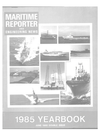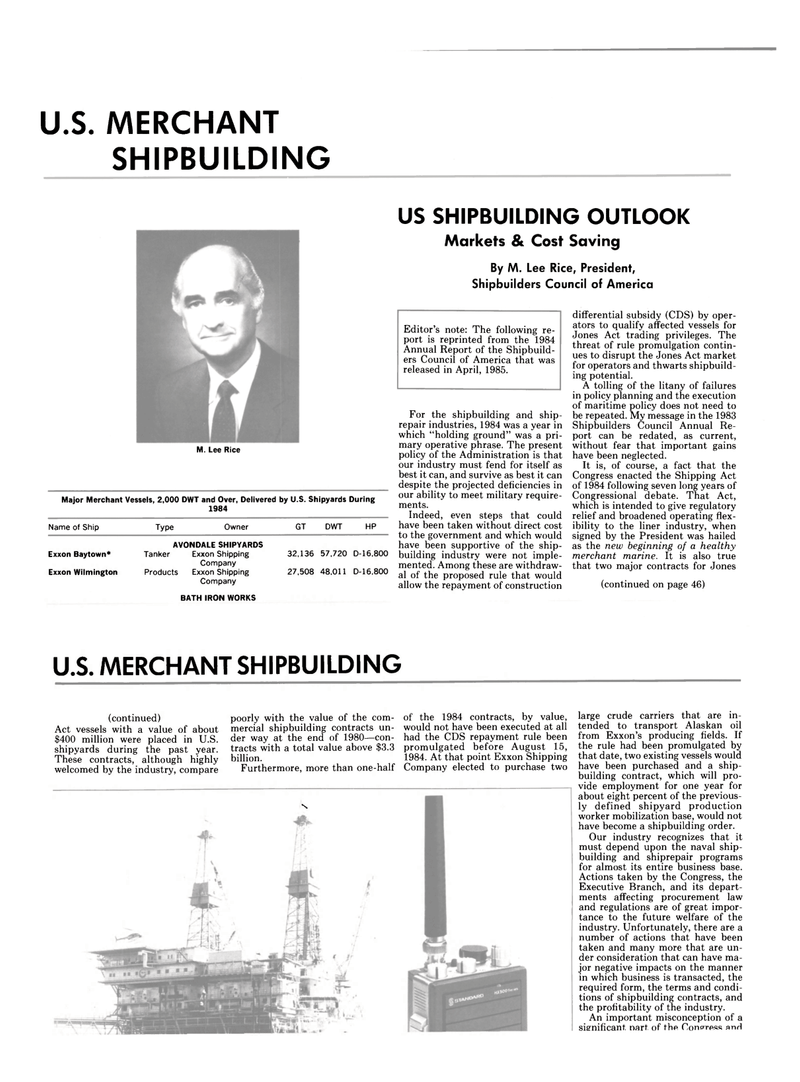
Page 44: of Maritime Reporter Magazine (June 1985)
Read this page in Pdf, Flash or Html5 edition of June 1985 Maritime Reporter Magazine
U.S. MERCHANT
SHIPBUILDING
M. Lee Rice
Major Merchant Vessels, 2,000 DWT and Over, Delivered by U.S. Shipyards During 1984
Name of Ship Type Owner GT DWT HP
Exxon Baytown*
Exxon Wilmington
AVONDALE SHIPYARDS
Tanker Exxon Shipping
Company
Products Exxon Shipping
Company
BATH IRON WORKS
US SHIPBUILDING OUTLOOK
Markets & Cost Saving
By M. Lee Rice, President,
Shipbuilders Council of America
Editor's note: The following re- port is reprinted from the 1984
Annual Report of the Shipbuild- ers Council of America that was released in April, 1985. 32,136 57,720 D-16,800 27,508 48,011 D-16,800
For the shipbuilding and ship- repair industries, 1984 was a year in which "holding ground" was a pri- mary operative phrase. The present policy of the Administration is that our industry must fend for itself as best it can, and survive as best it can despite the projected deficiencies in our ability to meet military require- ments.
Indeed, even steps that could have been taken without direct cost to the government and which would have been supportive of the ship- building industry were not imple- mented. Among these are withdraw- al of the proposed rule that would allow the repayment of construction differential subsidy (CDS) by oper- ators to qualify affected vessels for
Jones Act trading privileges. The threat of rule promulgation contin- ues to disrupt the Jones Act market for operators and thwarts shipbuild- ing potential.
A tolling of the litany of failures in policy planning and the execution of maritime policy does not need to be repeated. My message in the 1983
Shipbuilders Council Annual Re- port can be redated, as current, without fear that important gains have been neglected.
It is, of course, a fact that the
Congress enacted the Shipping Act of 1984 following seven long years of
Congressional debate. That Act, which is intended to give regulatory relief and broadened operating flex- ibility to the liner industry, when signed by the President was hailed as the new beginning of a healthy merchant marine. It is also true that two major contracts for Jones (continued on page 46)
U.S. MERCHANT SHIPBUILDING (continued)
Act vessels with a value of about $400 million were placed in U.S. shipyards during the past year.
These contracts, although highly welcomed by the industry, compare poorly with the value of the com- mercial shipbuilding contracts un- der way at the end of 1980—con- tracts with a total value above $3.3 billion. of the 1984 contracts, by value, would not have been executed at all had the CDS repayment rule been promulgated before August 15, 1984. At that point Exxon Shipping
Furthermore, more than one-half Company elected to purchase two x large crude carriers that are in- tended to transport Alaskan oil from Exxon's producing fields. If the rule had been promulgated by that date, two existing vessels would have been purchased and a ship- building contract, which will pro- vide employment for one year for about eight percent of the previous- ly defined shipyard production worker mobilization base, would not have become a shipbuilding order.
Our industry recognizes that it must depend upon the naval ship- building and shiprepair programs for almost its entire business base.
Actions taken by the Congress, the
Executive Branch, and its depart- ments affecting procurement law and regulations are of great impor- tance to the future welfare of the industry. Unfortunately, there are a number of actions that have been taken and many more that are un- der consideration that can have ma- jor negative impacts on the manner in which business is transacted, the required form, the terms and condi- tions of shipbuilding contracts, and the profitability of the industry.
An important misconception of a significant, nart of thp Coriorpss and

 43
43

 45
45
